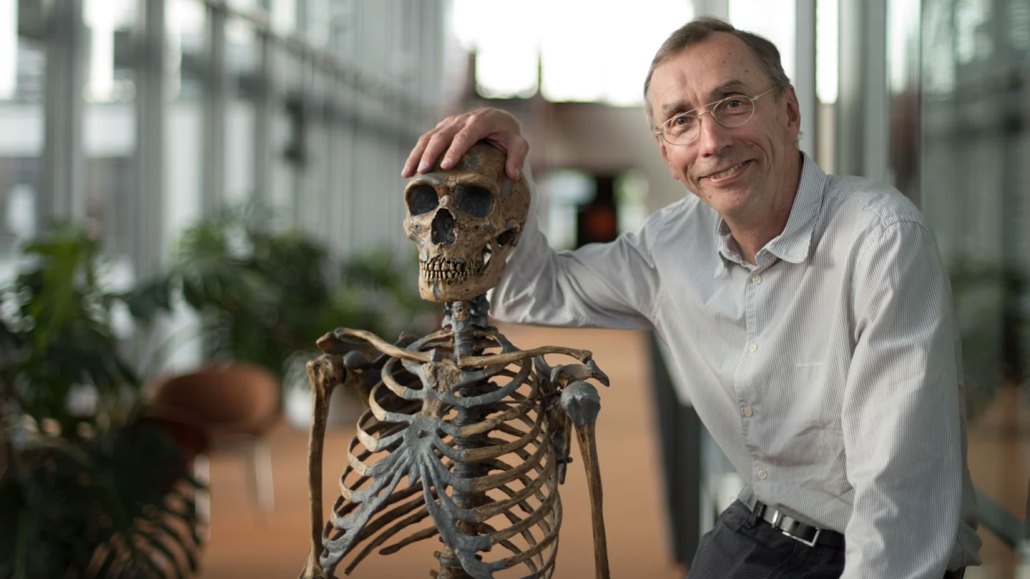Genetics of human evolution wins 2022 Nobel Prize in physiology or medicine
Geneticist Svante Pääbo figured out how to extract DNA from Neandertals’ and Denisovans’ bones

Svante Pääbo won the 2022 Nobel Prize in physiology or medicine for his pioneering work in deciphering the genetics of our hominid relatives, Neandertals and Denisovans.
© Karsten Möbius
By Tina Hesman Saey and Aimee Cunningham
- More than 2 years ago
Updated
Read another version of this article at Science News Explores
Establishing a new field of science to answer the question of what makes humans unique from our extinct relatives has earned Svante Pääbo the Nobel Prize in physiology or medicine.
“Humanity has always been intrigued by its origins. Where did we come from and how are we related to those who came before us? What makes us different from hominins that went extinct?” said Anna Wedell, a member of the Nobel Assembly at the Karolinska Institute in Stockholm that announced the prize on October 3.
Before Pääbo’s work, archaeologists and paleontologists studied bones and artifacts to learn about human evolution. But the surface study of those relics couldn’t answer some fundamental questions about the genetic changes that led humans to thrive while other ancient hominids went extinct. Pääbo, a geneticist at the Max Planck Institute for Evolutionary Anthropology in Leipzig, Germany, worked out a way to extract and analyze DNA from ancient bones (SN: 11/15/06). That led to uncovering small genetic differences between humans and extinct human relatives.
Getting DNA from ancient bones was once considered impossible, says Leslie Vosshall, a neuroscientist at the Rockefeller University in New York City, who is the vice president and chief scientific officer at the Howard Hughes Medical Institute. DNA breaks down over time, so many scientists thought that there would be none remaining in fossils tens of thousands of years old. Not to mention that DNA from bacteria and other microbes and from living people contaminate the ancient genetic material. Yet Pääbo managed to stitch together tiny fragments of Neandertal DNA into readable sequences. He started with DNA from mitochondria, the energy-generating organelles inside cells. Then, he assembled a complete genetic instruction book, or genome, for a Neandertal.
Over the years Vosshall watched as Pääbo presented snippets of DNA from old bones at scientific meetings. “Nobody believed him. Everyone thought it was contamination or broken stuff” from living people. “Just the mere fact that he did it was so improbable. That he was able to get the complete genome sequence of a Neandertal was viewed, even up until he did it, as an absolutely impossible feat.”
“On a technical basis, the prize is also richly deserved,” she says.
Noted Nils-Göran Larsson, vice chairman of the Nobel committee: “This is a very fundamental, big discovery… Over the years to come, [this] will give huge insights into human physiology.”
Pääbo’s work established the field of paleogenomics. “He always pushed the frontiers of evolutionary anthropology,” says Ludovic Orlando, a molecular archaeologist at the Centre for Anthropobiology and Genomics of Toulouse in France.
Pääbo said that when he got the news of his win, he thought at first it was an “elaborate prank” by the people in his research group, but soon realized it was the real deal. “The thing that is amazing to me is that we now have some ability to go back in time and actually follow genetic history and genetic changes over time,” he said in a news conference several hours after the prize was announced.
Pääbo and colleagues have made surprising discoveries about human evolution from studying ancient DNA. For instance, they learned that humans and our extinct cousins, Neandertals, had children together. That discovery came as a shock to even people who had been looking for signs of interbreeding (SN: 5/6/10). Evidence of that mixing can still be found in many humans today (SN: 10/10/17).
Pääbo’s study of a finger bone revealed a previously undiscovered extinct human relative called Denisovans (SN: 8/30/12). Like Neandertals, Denisovans interbred with humans.
DNA passed down from those extinct ancestors has influenced human health and physiology for better or worse. For instance, genetic variants inherited from Denisovans helped humans adapt to high altitude in Tibet (SN: 7/2/14). But some Neandertal DNA has been linked to a higher risk of developing some diseases, including severe COVID-19 (SN: 2/11/16; SN: 10/2/20).
His work has also delved into tiny genetic changes that may have influenced the evolution of the human brain (SN: 2/26/15). Other researchers have also applied techniques Pääbo developed to study evolution and domestication of animals (SN: 7/6/17), and to learn about how ancient humans moved around the world.
“He’s a singular scientist,” Vosshall says.
He’s not the only one in his family to win a Nobel Prize, though. Pääbo’s father, Sune Bergström, shared the medicine Nobel Prize in 1982 (SN: 10/16/82).
Pääbo will take home prize money of 10 million Swedish kronor, roughly $895,000 as of October 3.







